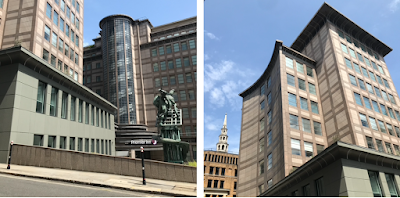This is the third part of my wandering up and down the streets between the BM and Bloosmsbury Way, following on from my posts about what I think could be a very old coal hole cover and the Dairy Supply Co/Pizza Express building...
Leaving Museum Street, I wandered into Gilbert Place and looked back towards Centrepoint – a wonderful patchwork of architecture through the ages. Halfway down the street at 8, 9 and 10, the windows are protected by some chunky yet fancy metal railings – is there a proper name for these things? Sunny reflections from the windows opposite.
Similar houses with these additions can be found backing onto these properties in Little Russell Street. At the end of the street at the junction with Bury Place there is, beneath the old Borough of Holborn street sign, a faded metal one that says 'formerly' at the top, but I cannot as yet make out the bottom section. The street is listed as Gilbert Place in 1882 but was simply Gilbert Street pre that, as shown on the map Charles Booth used for his poverty maps. Hardly seems worth the effort, especially as there weren’t lots of other Gilbert Streets in London at that time.
Almost below this street sign two colourful doorways create a nice pattern at step level and nearby, in Bury Place, Bertand Russell, that very clever man, is commemorated with a blue plaque.
But then thud – an eyesore! I noticed some dreadful repairs in the brickwork of Museum Chambers, an 1884 residential block:
Clearly no attempt has been made to match the existing mortar and I suspect that squirty mastic has instead been applied. No no no! It's a cowboy job.
Good job I found Present & Correct, a delightful stationery shop across the road – wow, it's heaven in there. When I was a child, Rymans was my favourite shop – all those pens and erasers and bulldog clips and note pads and and and... I'd love to be able to time travel to a well-stocked Victorian stationery shop.
Then to the London Review bookshop and through Pied Bull Yard, exiting into Bloomsbury Square and left into Gt Russell St, turning back into Museum Street where I wanted to take snaps of some mosaic thresholds all of which are damaged or dirty in some way even though the shops above sell food or art or other expensive goods. Eh?!
The four tiles making a dodgy diamond infill is at No.29, today a ramen restaurant. This probably covers or replaces an ED logo for Express Dairies, a company I wrote about in my last post and here. The black and white terrazzo and small mosaics were likely installed in the early 1920s, replacing an earlier floral design as seen to the right.
Back to Gt Russell Street. At the corner, at No.48, there is a large souvenir shop called Distinctive London within an impressively embellished late Georgian building that boasts the most amazing vermiculation, the burgundy paintwork in this instance highlighting its features.
The wide doorway also features two defunct doorbells, one each side, no doubt one for Visitors and one for Trade. A few doors along Jarndyce's shop shows hints of an earlier business. Beneath the thick paint a ghostsign for oriental (something) can be seen:
At street level in front of most of the buildings along Gt Russell Street there are chunky metal grilles allowing daylight into the basements below. Indeed, in most places, the below ground windows are visible but it doesn't look like any of these are inhabited, probably used for storage. It's more common to see metal grilles replaced by panels of pavement lights, such as the ones made by Hayward Bros that allowed much more light into the basement spaces. However, in the years before these properties became shops, the grilles would have prohibited people from walking on them, therefore keeping the tourists slightly at bay.
A couple of the grilles bear the name of the company that made them: G B Cooper, Drury Lane. Kelly's 1852 street directory shows George Binion Cooper, ironfounder, at 121 Drury Lane and the Trades section of that same year, as shown below, lists another shop in nearby Endell Street and premises in Lambeth which I suspect was the foundry as this is where many businesses of that ilk were located. He's clearly our our man, though I don't know when he started trading or when the grilles were made.
I'm now going to be looking out for more of the same on other gates. Let me know if you find any yourself.
Back to Gt Russell Street, specifically to another souvenir shop on the British Museum side of the street, where two pairs of sturdy boot scrapers flank the door of No.91 but are often obscured by merchandise. Four scrapers is a lot and this suggests the building had a lot of footfall. Above the door there is a group of busy cherubs – these probably allude to the wholesale perfumery business that was here in the name of Andrew and Francis Pears – yep, Pears' soap!
There has also been at least one other company at this address, as is shown by hints of some removed letters on the glass. I can make out Canadian Works along the bottom edge. This is intriguing. Another work in progress.
Back into Coptic Street and left into Little Russell Street where, at No.27, there is a lovely 1879 parochial school building.
The small plaque between the two skinny windows says, 'For the children of the schools of the united parishes of St. Giles in the Fields & St. George Bloomsbury in lieu of the original building in Museum Street'. Nice.
Between the school building and the rear of St. George's church, I noticed a double man hole cover which got me thinking about ELO and, because it was such a gloriously sunny day, I wandered off singing Mr Blue Sky.



























































